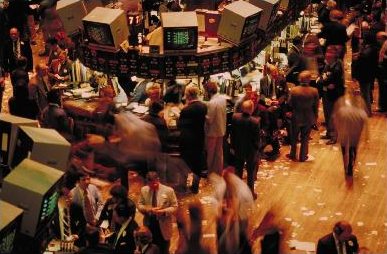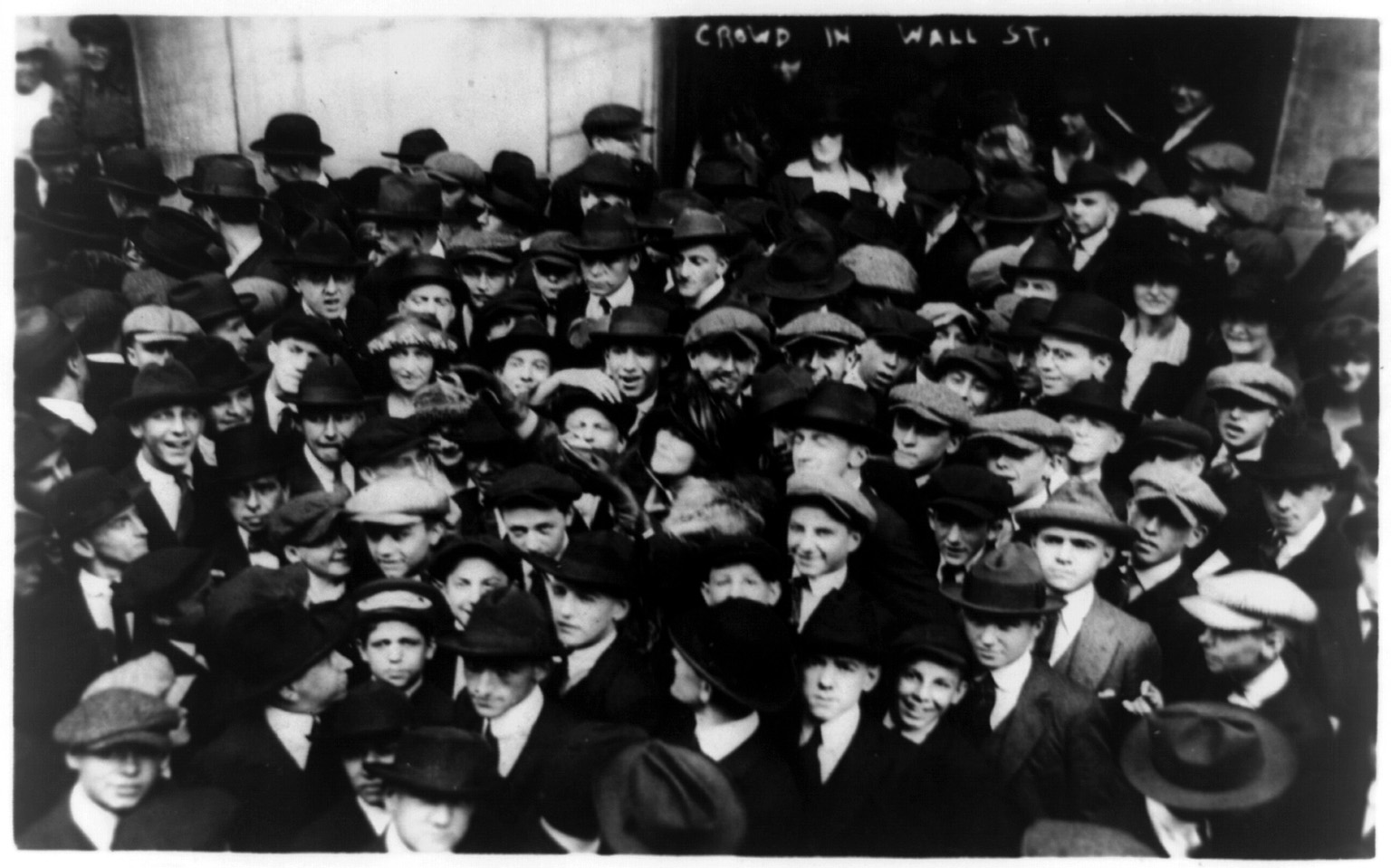|
Hand Signaling (open Outcry)
Hand signaling, also known as arb or arbing (short for arbitrage), is a system of hand signals used on financial trading floors to communicate buy and sell information in an open outcry trading environment. The system is used at financial exchanges such as the Chicago Mercantile Exchange (CME) and the American Stock Exchange (AMEX). The AMEX is the only U.S. stock market to permit the transmission of buy and sell orders through hand signals.Larry Harris, ''Trading and Exchanges'', Oxford University Press US: 2003, page 104, , Traders usually flash the signals quickly across a room to make a sale or a purchase. Signals that occur with palms facing out and hands away from the body are an indication the gesturer wishes to sell. When traders face their palms in and hold their hands up, they are gesturing to buy. Numbers one through five are gestured on one hand with the fingers pointing directly upwards. To indicate six through ten, the hand is held sideways, parallel to the ground. Co ... [...More Info...] [...Related Items...] OR: [Wikipedia] [Google] [Baidu] |
Arbitrage
In economics and finance, arbitrage (, ) is the practice of taking advantage of a difference in prices in two or more markets; striking a combination of matching deals to capitalise on the difference, the profit being the difference between the market prices at which the unit is traded. When used by academics, an arbitrage is a transaction that involves no negative cash flow at any probabilistic or temporal state and a positive cash flow in at least one state; in simple terms, it is the possibility of a risk-free profit after transaction costs. For example, an arbitrage opportunity is present when there is the possibility to instantaneously buy something for a low price and sell it for a higher price. In principle and in academic use, an arbitrage is risk-free; in common use, as in statistical arbitrage, it may refer to ''expected'' profit, though losses may occur, and in practice, there are always risks in arbitrage, some minor (such as fluctuation of prices decreasing profit ... [...More Info...] [...Related Items...] OR: [Wikipedia] [Google] [Baidu] |
Open Outcry
Open outcry is a method of communication between professionals on a stock exchange or futures exchange, typically on a trading floor. It involves shouting and the use of hand signals to transfer information primarily about buy and sell orders. floor trading hand signals The part of the trading floor where this takes place is called a ''pit''. In an open outcry auction, bids and offers must be made out in the open market, giving all participants a chance to compete for the order with the best price. New bids or offers would be made if better than previous pricing for efficient price discovery. Exchanges also value positions marked to these public market prices on a daily basis. In contrast, over-the-counter markets are where bids and offers are negotiated privately between principals. Since the development of the stock exchange in the 17th century in Amsterdam, open outcry was the main method used to communicate among traders. This started changing in the latter half o ... [...More Info...] [...Related Items...] OR: [Wikipedia] [Google] [Baidu] |
Chicago Mercantile Exchange
The Chicago Mercantile Exchange (CME) (often called "the Chicago Merc", or "the Merc") is a global derivatives marketplace based in Chicago and located at 20 S. Wacker Drive. The CME was founded in 1898 as the Chicago Butter and Egg Board, an agricultural commodities exchange. Originally, the exchange was a non-profit organization. The Merc demutualized in November 2000, went public in December 2002, and merged with the Chicago Board of Trade in July 2007 to become a designated contract market of the CME Group Inc., which operates both markets. The chairman and chief executive officer of CME Group is Terrence A. Duffy, Bryan Durkin is president. On August 18, 2008, shareholders approved a merger with the New York Mercantile Exchange (NYMEX) and COMEX. CME, CBOT, NYMEX, and COMEX are now markets owned by CME Group. After the merger, the value of the CME quadrupled in a two-year span, with a market cap of over $25 billion. Today, CME is the largest options and futures con ... [...More Info...] [...Related Items...] OR: [Wikipedia] [Google] [Baidu] |
American Stock Exchange
NYSE American, formerly known as the American Stock Exchange (AMEX), and more recently as NYSE MKT, is an American stock exchange situated in New York City. AMEX was previously a mutual organization, owned by its members. Until 1953, it was known as the New York Curb Exchange. NYSE Euronext acquired AMEX on October 1, 2008, with AMEX integrated with the Alternext European small-cap exchange and renamed the NYSE Alternext U.S. In March 2009, NYSE Alternext U.S. was changed to NYSE Amex Equities. On May 10, 2012, NYSE Amex Equities changed its name to NYSE MKT LLC. Following the SEC approval of competing stock exchange IEX in 2016, NYSE MKT rebranded as NYSE American and introduced a 350-microsecond delay in trading, referred to as a "speed bump", which is also present on the IEX. History The Curb market The exchange grew out of the loosely organized curb market of curbstone brokers on Broad Street in Manhattan. Efforts to organize and standardize the market started early in ... [...More Info...] [...Related Items...] OR: [Wikipedia] [Google] [Baidu] |
Kibibyte
The byte is a unit of digital information that most commonly consists of eight bits. Historically, the byte was the number of bits used to encode a single character of text in a computer and for this reason it is the smallest addressable unit of memory in many computer architectures. To disambiguate arbitrarily sized bytes from the common 8-bit definition, network protocol documents such as The Internet Protocol () refer to an 8-bit byte as an octet. Those bits in an octet are usually counted with numbering from 0 to 7 or 7 to 0 depending on the bit endianness. The first bit is number 0, making the eighth bit number 7. The size of the byte has historically been hardware-dependent and no definitive standards existed that mandated the size. Sizes from 1 to 48 bits have been used. The six-bit character code was an often-used implementation in early encoding systems, and computers using six-bit and nine-bit bytes were common in the 1960s. These systems often had memory words ... [...More Info...] [...Related Items...] OR: [Wikipedia] [Google] [Baidu] |
Chinese Number Gestures
Chinese number gestures are a method to signify the natural numbers one through ten using one hand. This method may have been developed to bridge the many varieties of Chinese—for example, the numbers 4 () and 10 () are hard to distinguish in some dialects. Some suggest that it was also used by business people during bargaining (i.e., to convey a bid by feeling the hand gesture in a sleeve) when they wish for more privacy in a public place. These gestures are fully integrated into Chinese Sign Language. Methods While the five digits on one hand can easily express the numbers one through five, six through ten have special signs that can be used in commerce or day-to-day communication. The gestures are rough representations of the Chinese numeral characters they represent. The system varies in practice, especially for the representation of "7" to "10". Two of the systems are listed below: * Six ( 六) **The little finger and thumb are extended, other fingers closed, sometime ... [...More Info...] [...Related Items...] OR: [Wikipedia] [Google] [Baidu] |
Finger Binary
Finger binary is a system for counting and displaying binary numbers on the fingers of either or both hands. Each finger represents one binary digit or bit. This allows counting from zero to 31 using the fingers of one hand, or 1023 using both: that is, up to 25−1 or 210−1 respectively. Using all ten toes as well would theoretically increase this to 1,048,575, but it seems unlikely that many people have the dexterity for this. Modern computers typically store values as some whole number of 8-bit bytes, making the fingers of both hands together equivalent to 1 bytes of storage—in contrast to less than half a byte when using ten fingers to count up to 10.Since computers typically store data in a minimum size of one whole byte, fractions of a byte are used here only for comparison. Mechanics In the binary number system, each numerical digit has two possible states (0 or 1) and each successive digit represents an increasing power of two. Note: What follows is but ... [...More Info...] [...Related Items...] OR: [Wikipedia] [Google] [Baidu] |
Nonverbal Communication
Nonverbal communication (NVC) is the transmission of messages or signals through a nonverbal platform such as eye contact, facial expressions, gestures, Posture (psychology), posture, and body language. It includes the use of social cues, kinesics, distance (proxemics) and physical environments/appearance, of voice (paralanguage) and of touch (Haptic communication, haptics). A signal has three different parts to it, including the basic signal, what the signal is trying to convey, and how it is interpreted. These signals that are transmitted to the receiver depend highly on the knowledge and empathy that this individual has. It can also include the use of time (chronemics) and eye contact and the actions of looking while talking and listening, frequency of glances, patterns of fixation, pupil dilation, and blink rate (oculesics). The study of nonverbal communication started in 1872 with the publication of ''The Expression of the Emotions in Man and Animals'' by Charles Darwin. Dar ... [...More Info...] [...Related Items...] OR: [Wikipedia] [Google] [Baidu] |
Sign Language
Sign languages (also known as signed languages) are languages that use the visual-manual modality to convey meaning, instead of spoken words. Sign languages are expressed through manual articulation in combination with non-manual markers. Sign languages are full-fledged natural languages with their own grammar and lexicon. Sign languages are not universal and are usually not mutually intelligible, although there are also similarities among different sign languages. Linguists consider both spoken and signed communication to be types of natural language, meaning that both emerged through an abstract, protracted aging process and evolved over time without meticulous planning. Sign language should not be confused with body language, a type of nonverbal communication. Wherever communities of deaf people exist, sign languages have developed as useful means of communication and form the core of local Deaf cultures. Although signing is used primarily by the deaf and hard of hearing, ... [...More Info...] [...Related Items...] OR: [Wikipedia] [Google] [Baidu] |





